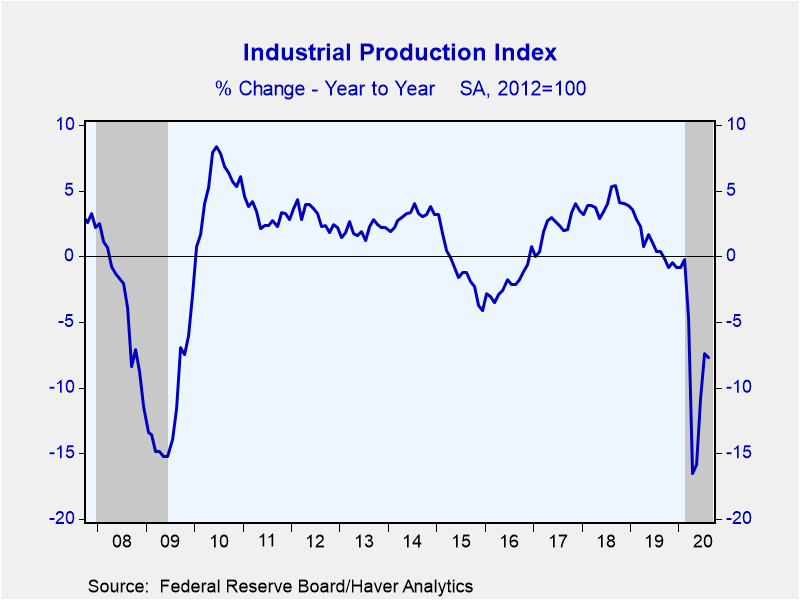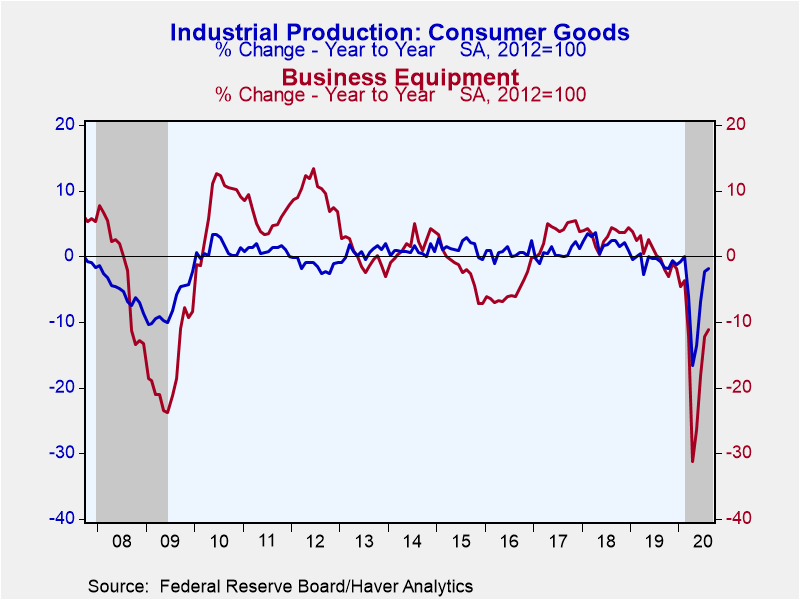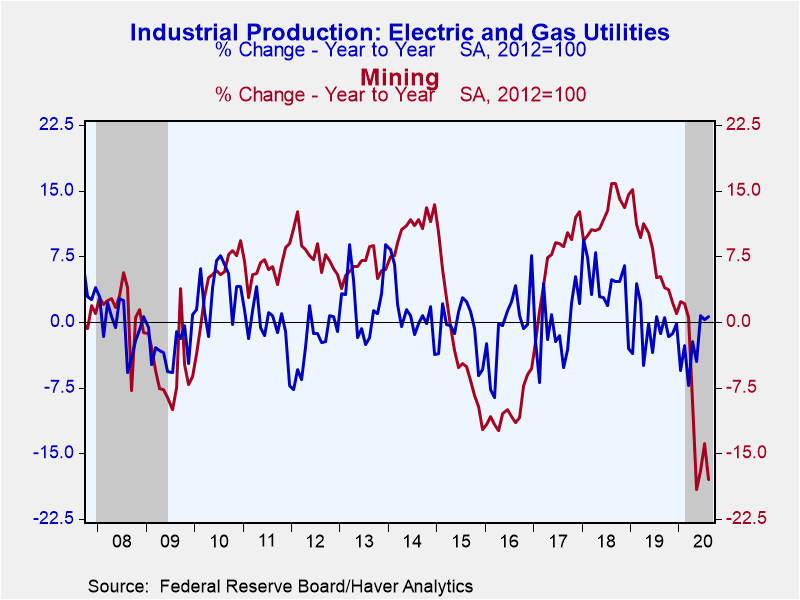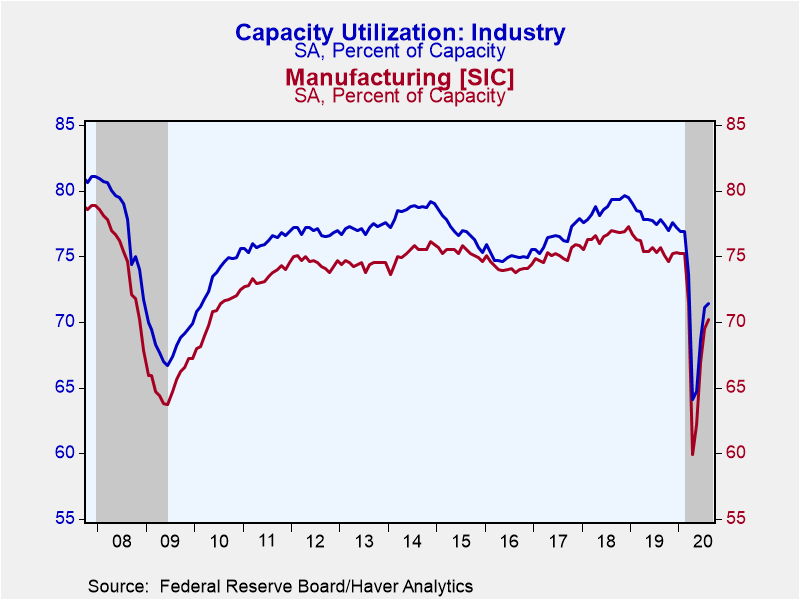 Global| Sep 15 2020
Global| Sep 15 2020U.S. Industrial Production Gain Moderates in August
by:Tom Moeller
|in:Economy in Brief
Summary
• Manufacturing output remains strong. • High Tech and nondurable goods sectors are notably firm. • Capacity usage is unconstrained. Industrial production increased 0.4% (-7.7% y/y) during August following a 3.5% jump in July, revised [...]
• Manufacturing output remains strong.
• High Tech and nondurable goods sectors are notably firm.
• Capacity usage is unconstrained.
Industrial production increased 0.4% (-7.7% y/y) during August following a 3.5% jump in July, revised from 3.0%. A 1.0% increase had been expected by in the Action Economics Forecast Survey.
Manufacturing production gained 1.0% (-6.9% y/y) last month following a 3.9% July increase, revised from 3.4%. Output of nondurable goods increased 1.2% (-5.0% y/y) following a 1.5% July rise. Clothing output surged 8.1% after falling 2.6% (-11.5% y/y) in July while food & tobacco production rose 1.0% (-0.9% y/y). Chemical production gained 0.5% (-3.7% y/y) while paper output rose 0.5% (-13.1% y/y) after falling 1.4% in July. Production of durable goods rose 0.7% after surging 3.9% in July. The gain was led by a 2.0% rise (-3.4% y/y) in appliance, furniture & carpeting production which followed three straight months of even stronger increase. Output of computers, audio & video equipment gained 2.2% (0.8% y/y) but automotive product production declined 3.7% (-1.9% y/y), after surging during the prior three months.
Business equipment production strengthened 1.9% (-11.2% y/y) after three months of strong increase. Information processing equipment strengthened 2.0% (8.4% y/y) after two months of strong gain and transit equipment production improved 2.7% (-28.3% y/y) after jumping by roughly one-third during July.
Production of selected high-technology products improved 1.2% (5.0% y/y) led by a 3.1% jump (4.8% y/y) in computer output. Communications equipment production rose 0.9% (0.7% y/y) and semiconductor production rose 0.7% (6.7% y/y).
Utilities output eased 0.4% (+0.6% y/y) while mining output declined 2.5% m/m (-18.0% y/y) in August.
Capacity utilization rose to 71.4% during August from 71.1% in July, revised from 70.6%. The Action Economics Forecast Survey called for 71.3%. Factory sector utilization increased to 70.2% last month from 69.5%. The latest level was a five-month high.
Industrial production and capacity are located in Haver's USECON database. Additional detail on production and capacity can be found in the IP database. The expectations figures come from the AS1REPNA database.
| Industrial Production (SA, % Change) | Aug | Jul | Jun | Aug Y/Y | 2019 | 2018 | 2017 |
|---|---|---|---|---|---|---|---|
| Total Output | 0.4 | 3.5 | 6.1 | -7.7 | 0.9 | 4.0 | 2.3 |
| Manufacturing | 1.0 | 3.9 | 7.5 | -6.9 | -0.2 | 2.3 | 2.0 |
| Durable Goods | 0.7 | 6.5 | 12.1 | -8.0 | 0.7 | 3.4 | 2.2 |
| Motor Vehicles | -3.7 | 31.7 | 119.5 | -1.9 | -2.3 | 4.1 | 0.0 |
| Selected High Tech | 1.2 | 2.1 | 2.3 | 5.0 | 5.1 | 6.4 | 2.6 |
| Nondurable Goods | 1.2 | 1.5 | 3.5 | -5.0 | -0.7 | 1.9 | 1.9 |
| Utilities | -0.4 | 3.8 | 1.3 | 0.6 | -0.8 | 4.4 | -0.8 |
| Mining | -2.5 | 1.4 | 3.0 | -18.0 | 7.1 | 12.4 | 7.4 |
| Capacity Utilization (%) | 71.4 | 71.1 | 68.7 | 77.8 | 77.8 | 78.7 | 76.5 |
| Manufacturing | 70.2 | 69.5 | 66.9 | 75.7 | 75.6 | 76.6 | 75.1 |
Tom Moeller
AuthorMore in Author Profile »Prior to joining Haver Analytics in 2000, Mr. Moeller worked as the Economist at Chancellor Capital Management from 1985 to 1999. There, he developed comprehensive economic forecasts and interpreted economic data for equity and fixed income portfolio managers. Also at Chancellor, Mr. Moeller worked as an equity analyst and was responsible for researching and rating companies in the economically sensitive automobile and housing industries for investment in Chancellor’s equity portfolio. Prior to joining Chancellor, Mr. Moeller was an Economist at Citibank from 1979 to 1984. He also analyzed pricing behavior in the metals industry for the Council on Wage and Price Stability in Washington, D.C. In 1999, Mr. Moeller received the award for most accurate forecast from the Forecasters' Club of New York. From 1990 to 1992 he was President of the New York Association for Business Economists. Mr. Moeller earned an M.B.A. in Finance from Fordham University, where he graduated in 1987. He holds a Bachelor of Arts in Economics from George Washington University.










